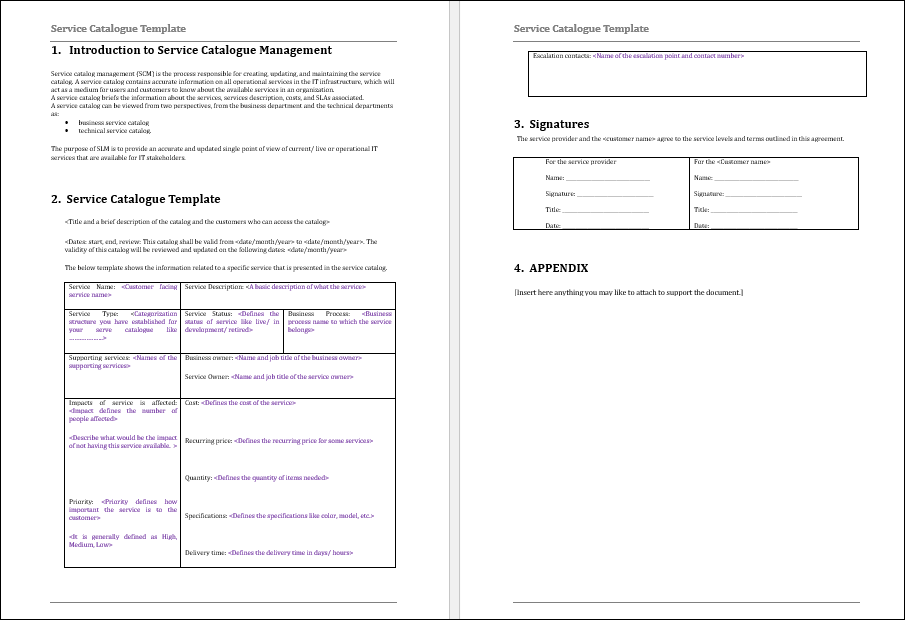Service Catalog Template
Introduction
A Service Catalogue Template in IT Governance is an organised and standardised document that describes the numerous IT services provided by an organisation, including thorough descriptions, service owners, associated stakeholders, service levels, dependencies, charges, and pricing models. This template serves as a thorough guide for aligning IT services with business objectives, allowing for more effective communication between IT and other groups. By giving a clear and organised overview of available services, the template improves service delivery, resource management, and overall IT governance efficiency. It also provides a framework for strategic decision-making, allowing organisations to optimise their IT infrastructure in line with organisational goals and industry best practices.

Importance Of Service Catalog Template
The Service Catalogue is critical in IT Governance since it is a complete and well-organized archive of an organization's IT services. It serves as an important communication tool, providing stakeholders with clear information about available services, standards, and associated service levels. This transparency is critical for establishing alignment between IT and business objectives, allowing decision-makers to make more informed decisions about resource allocation, strategic planning, and overall IT service management.
Implementing A Service Catalog Template
Here is a step-by-step guide to help you navigate through the process:
1. Define Objectives and Scope:
- Clearly define the aims for deploying the Service Catalogue Template.
- Identify the extent of services to be covered, taking into account both customer-facing and internal IT services.
2. Engage Stakeholders:
- Involve important stakeholders such as IT leaders, service owners, and representatives from different business units.
- Gather information about service definitions, expectations, and requirements.
3. Select a Template Format:
- Select a template format that is consistent with organisational needs and industry best practices.
- Ensure that the template has sections for service descriptions, service levels, owners, costs, and dependencies.
4. Define Service Descriptions:
- Work together to develop clear and succinct explanations for each IT service.
- Make sure the terminology used is understandable to both technical and non-technical stakeholders.
5. Assign Service Owners and Stakeholders:
- Identify and assign accountable owners to each service.
- Define the roles and responsibilities of all parties participating in the service delivery process.
6. Establish Service Levels and Metrics:
- Define the service levels for each offering, such as response times, resolution times, and availability.
- Create meaningful metrics for tracking and evaluating the performance of each service.
7. Document Service Dependencies:
- Identify and record the dependencies between various IT services.
- Develop measures to reduce the hazards associated with dependency.
8. Determine Service Costs and Pricing:
- Determine the cost of providing each service, including both direct and indirect costs.
- Create pricing models for services, if applicable, taking into account budget limits and market benchmarks.

Benefits Of Service Catalog Template
- Enhanced Visibility and Transparency: Creates a centralised and accessible repository for all IT services, giving stakeholders a clear picture of available offers, associated prices, and service levels.
- Improved Communication: Allows for more effective communication between IT teams and other business units by defining and articulating IT services in a standardised, easily understandable format.
- Strategic Alignment: Aligns IT services with overall company goals, ensuring that resources are deployed efficiently and that IT efforts contribute directly to organisational success.
- Efficient Service Delivery: Provides a standardised and well-documented framework for service delivery, eliminating ambiguity and increasing speed and accuracy.
- Optimized Resource Management: Improves resource allocation by explicitly specifying service dependencies, ownership, and performance measurements, resulting in more efficient use of IT resources.
Conclusion
Implementing a Service Catalogue Template is a critical component of IT governance, providing numerous benefits that go beyond the scope of standard service management. The Service Catalogue is an essential tool for organisations looking to match their technical endeavours with overarching business objectives since it provides a centralised library of IT services with clear descriptions, standardised processes, and transparent communication. The Service Catalog's increased visibility and openness enable stakeholders to make informed decisions, promoting collaboration between IT teams and business divisions.

